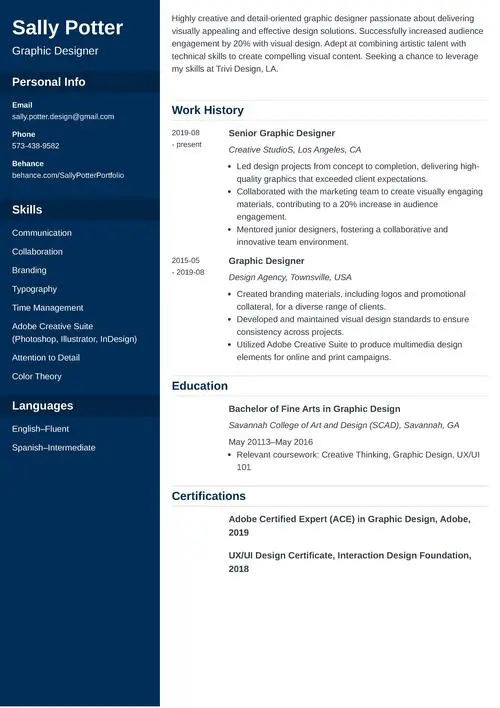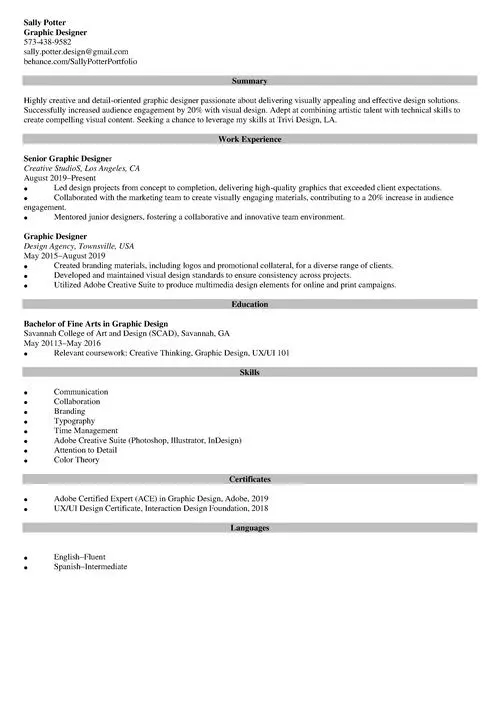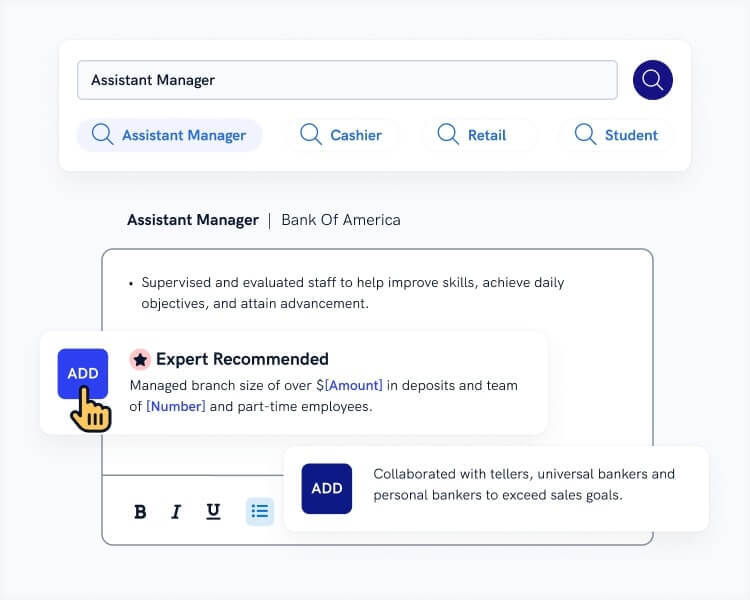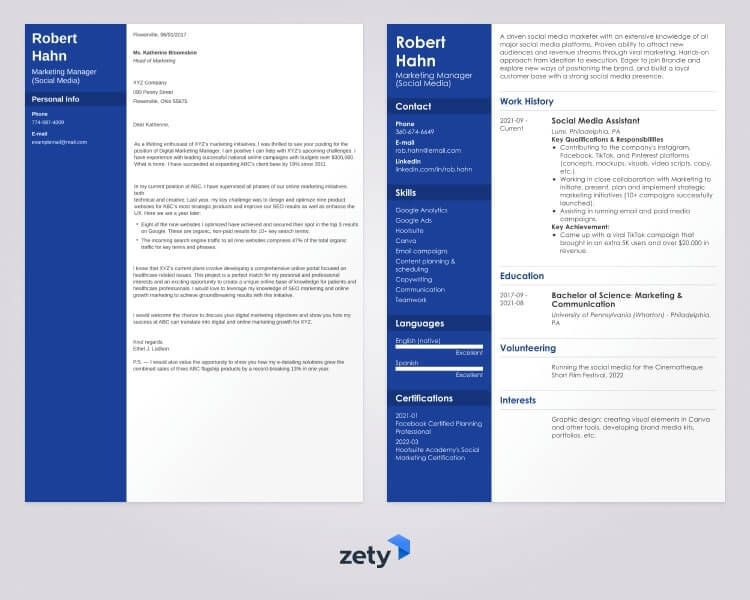Visual aesthetics, working closely with all kinds of people, and all that under the pressure of time and quality. As a graphic designer, you need a perfect resume to show you can do it all and operate on different software. To nail it, you should create a perfect list of graphic design skills.
Color your recruiters’ world with a resume showing you have the graphic designer skills they seek. Read on, and let me tell you how to do it right.
This guide will show you:
- Top graphic design resume skills.
- Best ways of improving skills needed for graphic designers.
- How to show skills needed to be a graphic designer on your resume.
Want to save time and have your resume ready in 5 minutes? Try our resume builder. It’s fast and easy to use. Plus, you’ll get ready-made content to add with one click. Explore our free resume templates and start building your resume today.
Sample resume made with our builder—See more resume examples here.
Find where these skills might be useful in our other guides:
- Artist Resume Examples
- 3D Artist Resume Examples
- Animator Resume Examples
- Illustrator Resume Examples
- Interior Designer Resume Examples
- Photographer Resume Examples
- Game Design Resume Examples
- Fashion Designer Resume Examples
- UX Designer Resume & UI Developer
- 500+ More Resume Examples
What Are Graphic Designer Skills?
Before I list the 15 best graphic design resume skills, let’s take a quick look at a short definition of what those skills really are:
Graphic designer skills enable graphic designers to translate concepts into visual narratives, both in print and digital formats. They combine artistic abilities, technical proficiency, and a deep understanding of visual communication.
So, without further ado, let's explore the key skills every graphic designer should master to work creatively and effectively!
Since you’re looking for graphic design skills, you surely would benefit from visiting this guide: Graphic Design Resume Examples
15 Top Graphic Design Skills
According to the Bureau of Labor Statistics, about 22,800 openings for graphic designers are projected over the decade. Growing employment means you need to deliver a resume that stands out. Here are some skills that will help you do it well.
Communication
Showing clear and concise communication skills on a resume is a must for every graphic designer. Without them, you won’t be able to communicate with clients, team members, and stakeholders. Having them allows you to understand project requirements better, gather feedback, and ensure that the final design aligns with the client's vision.
Situations when communication skills can be used:
- Client meetings
- Presenting design concepts
- Collaborating with team members to ensure a shared understanding of project goals
Additional skills:
- Client management skills
- Active listening
- Articulating design concepts effectively
Creativity
Creative thinking drives innovative solutions and visually compelling designs. Graphic designers must think outside the box to generate unique concepts that effectively convey messages and captivate target audiences. Creativity allows you to stand out from others and create unusual designs. And that’s what your employer is always looking for.
Situations when creativity can be used:
- Conceptualizing design solutions
- Brainstorming ideas for a new project
- Finding creative approaches to overcome design challenges
Additional skills:
- Participation in design thinking workshops
- Staying updated on design trends
- Experimentation with new artistic techniques
Problem-Solving
Graphic designers often face challenges during the design process. Problem-solving skills enable you to analyze issues, develop effective solutions, and adapt your approach to meet project requirements. Plus, it shows you’re decisive and able to adjust to the constantly changing workflow, which is quite common in your work area.
Situations when problem-solving can be used:
- Facing design constraints
- Resolving technical issues in design software
- Adapting to unexpected changes in project scope
Additional skills:
- Critical thinking
- Adaptability
- Finding practical solutions to design obstacles
Time Management
To meet project deadlines and deliver high-quality work efficiently, you need to be great at time management. Designers must prioritize tasks, allocate time effectively, and ensure project progress according to the established timeline. It’s what makes you a trustworthy hire. And that’s always valuable.
Situations when time management can be used.
- Juggling multiple design projects simultaneously
- Meeting tight deadlines
- Maintaining a consistent workflow
Additional skills:
- Project management
- Task prioritization
- Ability to work efficiently under time constraints
Color Theory
A solid understanding of color theory helps you create visually appealing and harmonious designs. Designers must choose color schemes strategically to evoke specific emotions and enhance overall visual impact. Adding this skill to your graphic design resume skills will be as impactful as adding eye-catching colors to your project.
Situations when color theory can be used:
- Selecting color palettes for brand identities
- Ensuring accessibility in design
- Creating visually engaging compositions
Additional skills:
- Knowledge of the Pantone Matching System
- Creating gradients and blends
- Expertise in color psychology
Typography
In your work, colors are not the only things that matter. You must also have expertise in fonts. Otherwise, you won’t be able to communicate effectively through text. Designers must choose and arrange fonts thoughtfully, ensuring readability, hierarchy, and visual appeal in various design projects.
Situations when typography can be used:
- Designing textual elements for print and digital media
- Creating custom typographic elements for branding
- Applying hierarchy for visual communication
Additional skills:
- Hand lettering
- Understanding responsive typography
- Experimenting with diverse font combinations
Software
You won’t be handing your projects to your superior in the form of beautiful drawings. Vast knowledge of different graphic design software is an essential technical skill for you to have. Designers use various tools to create visual elements, manipulate images, and produce designs across different media.
Situations when software knowledge can be used:
- Editing and retouching photographs
- Creating digital artwork
- Incorporating visual effects into design compositions
Additional skills:
- Knowledge of advanced Photoshop tools and features
- Familiarity with InDesign & Illustrator plugins
- Expertise in photo manipulation
Brainstorming
Brainstorming allows graphic designers to generate a multitude of ideas and concepts. It also helps you use other people’s perspectives and ideas to get inspired and change your way of thinking before coming up with a fresh, brilliant idea. Using brainstorming sessions to explore creative solutions and gather diverse perspectives is valuable and keeps you on your toes.
Situations when brainstorming can be used:
- Initiating new projects
- Overcoming creative blocks
- Fostering collaborative idea generation among team members
Additional skills:
- Facilitating brainstorming sessions
- Open-mindedness
- Extracting valuable insights from group discussions
Branding
Understanding branding is critical for a successful graphic designer. Visual branding expertise involves creating a cohesive visual identity for brands. You must develop designs that align with brand values, adhere to established guidelines, and effectively represent the brand to the target audience. You can’t do it without the ability to understand branding.
Situations when branding can be used:
- Designing logos
- Developing brand guidelines
- Ensuring consistency across various brand collateral
Additional skills:
- Understanding of brand strategy
- Proficiency in packaging design
- Expertise in translating brand values visually
Collaboration
Collaboration skills allow you to thrive in interdisciplinary teams. Designers must effectively communicate and cooperate with team members, clients, and other stakeholders. After all, you’re not doing graphics for yourself, and many aspects come from different directions that can impact your work.
Situations when collaboration can be used:
- Collaborating on projects with other designers
- working with copywriters or marketing teams
- incorporating feedback from clients
Additional skills:
- Teamwork
- Effective communication in group settings
- Adaptability to varied working styles
Attention to Detail
Attention to detail ensures precision and accuracy in design elements. Designers must thoroughly review their work to identify and correct any inconsistencies and errors before handing a final product to their superior or directly to clients. Attention to detail proves your professionalism, which is always valuable.
Situations when attention to detail can be used:
- Checking for accuracy in design layouts
- reviewing typography for consistency
- Ensuring pixel-perfect precision
Additional skills:
- Quality assurance processes.
- Expert proofing and revision workflows
- Meticulous attention to small design details
Computer Skills
Apart from your expertise in graphic design software, you should also have significant computer skills. You must be proficient in navigating design software, managing files, and effectively using computers for your design work.
Situations when computer skills can be used:
- Operating design software
- Managing digital files
- Utilizing computer skills for an efficient design workflow
Additional skills:
- Familiarity with hardware components
- Troubleshooting software issues
- Adaptability to new technologies
Negotiation Skills
Negotiation skills are critical for graphic designers, especially in client interactions and project agreements. As a graphic designer, you must effectively communicate your value, discuss project scope, and negotiate terms and deadlines with clients and superiors. Without good negotiation skills, you’ll work day and night to deliver what others think should take only five minutes.
Situations when negotiation skills can be used:
- Negotiating project timelines
- Discussing design revisions
- Reaching agreements on project deliverables and compensation
Additional skills:
- Presentation skills
- Assertiveness
- Risk-assessment
Multitasking
Multitasking skills help you manage and prioritize multiple tasks simultaneously, ensuring efficiency and productivity in a fast-paced work environment. In a graphic design context, multitasking involves handling various design projects, meeting deadlines, and concurrently addressing different aspects of the creative process.
Situations when multitasking can be used
- Juggling multiple design projects
- Simultaneously working on various design elements
- Responding to client feedback
Additional skills:
- Resource allocation
- Time blocking
- Seamless transition between tasks
User Experience (UX) Design
Understanding User Experience (UX) Design is necessary for a graphic designer who wants to create visually compelling and user-friendly interfaces. UX Design involves crafting experiences prioritizing usability, accessibility, and user satisfaction. Graphic designers with UX Design skills conduct user research, create wireframes, and iterate on designs to optimize the overall user experience.
Situations when UX design can be used:
- Incorporating user feedback to improve website layouts
- Designing intuitive navigation menus for mobile applications
- Collaborating with UX designers to enhance the usability of digital interfaces
Additional skills:
- Usability testing
- Information Architecture
- Accessibility standards
Learn more about the best skills to impress the recruiter: Resume Skills Examples.
Making a resume with our builder is incredibly simple. Follow our step-by-step guide, use ready-made content tailored to your job and have a resume ready in minutes.
When you’re done, Zety’s resume builder will score your resume and our resume checker will tell you exactly how to make it better.
How to Learn Graphic Design Skills
Continuous learning and skill development are key to excel as a graphic designer. Here are some effective ways to enhance your graphic design skills:
Enroll in Online Courses
Numerous online platforms, such as Udemy or Coursea, offer courses on graphic design principles, software proficiency, and advanced techniques. Receiving a license shows that you’re still developing your skills and are willing to learn new things.
Practice with Real Projects
Apply your skills to real-world projects to gain hands-on experience and refine your abilities. Expanding the number of relevant work examples is always a great idea, as long as you’re not doing it as a charity, only to make your portfolio more impressive.
Join Design Communities
Connect with other graphic designers, participate in forums, and attend design meetups to learn from peers and stay updated on industry trends. That will easily allow you to remain in the loop, create professional connections, and maybe find a job or at least a good gig.
Now, let’s find out how to put those skills on a resume.
Pro tip: If you’re in a hurry and haven’t got time to develop those skills before sending a resume, consider adding some transferable skills to your resume.
How to Include Graphic Design Skills on a Resume
Your experience section should portray a combination of your hard and soft skills for a resume to work well. But how to do it properly? Let’s find out!
Here’s how to include your graphic designer skills on a resume:
- Distribute your skills in different parts of the resume you’re writing. Include them in the main skill section, along with your work experience, resume profile, and extra resume sections.
- Look at what skills were listed in the job ad and implement them when mentioning your resume skills. That way you’ll have resume keywords that will help you pass the ATS resume test, which allows your resume to land on recruiters’ desks.
- List up to 10 skills in your skill section. Making it longer will only lower the readability of your document. Plus, limiting this list is a great way of showing your high decision-making skills, which is valuable for all recruiters!
- Add a portfolio to back your skills with examples of your work.
And that’s it. You’re more than ready to fill your resume with amazing graphic designer skills. But before you do that, let’s have a quick recap!
Pro Tip: Consider creating a portfolio resume to impress your potential employers even more. Include not only your work but also any articles you were mentioned in, licenses, and relevant kudos from your colleagues, clients, and superiors.
Plus, a great cover letter that matches your resume will give you an advantage over other candidates. You can write it in our cover letter builder here. Here's what it may look like:
See more cover letter templates and start writing.
Key Takeaways
Now you know everything about graphic design skills for a resume. Let’s summarize what we’ve learned here today:
- Graphic design skills combine technical proficiency, artistic flair, and interpersonal abilities.
- Continuously learning, practicing, and adapting to industry trends will make you a perfect candidate for any graphic designer job.
- Showcasing these skills on your resume is crucial to get invited for a job interview.
Now you know all there is to know about graphic design skills. Good luck!
About Zety’s Editorial Process
This article has been reviewed by our editorial team to make sure it follows Zety's editorial guidelines. We’re committed to sharing our expertise and giving you trustworthy career advice tailored to your needs. High-quality content is what brings over 40 million readers to our site every year. But we don't stop there. Our team conducts original research to understand the job market better, and we pride ourselves on being quoted by top universities and prime media outlets from around the world.




